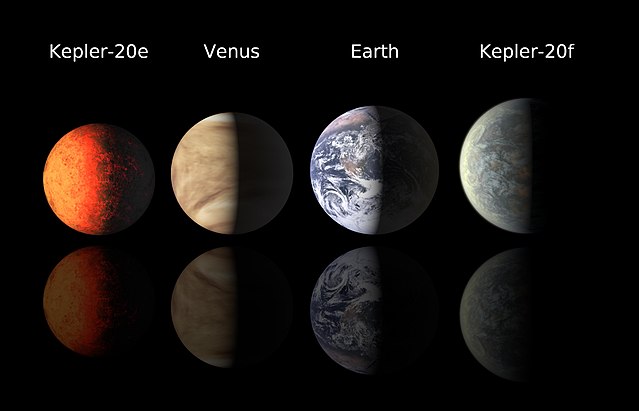 Exoplanets are planets outside our solar system. I had already prepared an X for this year’s A to Z. Then I watched this month’s Sky At Night programme on the search for life on Mars. That made me realise that the real search for life on other planets was far more of an inspiration to my writing than the extraterrestrials in other people’s fiction. I’ve saved that for next year. Then I saw an article on earthsky.org which confirmed that decision. I’ll come back to that later.
Exoplanets are planets outside our solar system. I had already prepared an X for this year’s A to Z. Then I watched this month’s Sky At Night programme on the search for life on Mars. That made me realise that the real search for life on other planets was far more of an inspiration to my writing than the extraterrestrials in other people’s fiction. I’ve saved that for next year. Then I saw an article on earthsky.org which confirmed that decision. I’ll come back to that later.
Exoplanets
I remember reading about the search for planets around other stars when I was much younger. Exoplanets were thought to be rare. Eventually a new generation of space scientists asked “why?” Why did we think we were so special, unique? Just because nobody had come to challenge us yet? How did we know they hadn’t? There’s a whole raft of science fiction writers asking what if we had been visited, and just didn’t know it? If you’re half my age you probably can’t imagine that people on earth could be so arrogant as to assume we were unique. Yet for a long time, HG Wells’ The War of the Worlds was about the only literature positing alien life.
Two major experiments started. Once we developed distributed computing[1] these experiments got enough computer power behind them to help produce, if not results, then enough data to suggest serious money should be thrown in certain directions.
The number of stars that turned out to be worth further examination turned out to be enormous. Just search for ‘exoplanets list’ and you will turn up several useful and reliable websites, including wikipedia, some of whom are updating their lists daily. As of February 2018, Wikipedia noted more than 3,700 confirmed exoplanets, with potentially over 5,000 more identified by the NASA Kepler space observatory mission. You can keep up to date with findings at the Exoplanet archive.
But is there life on these exoplanets?
The first exoplanet I remember hearing about was a gas giant, much larger than Jupiter, orbiting—and this was the big surprise—really very close to its sun. From memory it was in something like the position between our asteroid belt and Venus, and taking up all that space. It was going to be far too hot for life. Others were far too cold—way outside the habitable zone. That’s the area around a star in which life could find a reasonable range of temperatures in which it could survive.
Then when we discovered that we needed to change our minds about our own planets, based on data from Galileo and its successors. Some of Jupiter’s and Saturn’s moons looked surprisingly like they might be suitable for forms of life like to those we had discovered living under the Antarctic ice. The more we looked on Earth for life in completely inhospitable places, the more life we found. So why not under the ice of Titan or Enceladus? And now, we are also looking for life under the surface of Mars.
And if we have those conditions far out in our own system, maybe ‘earth-like’ exoplanets didn’t need to be in the habitable zone, or only on planets that could (once) support liquid water. Maybe life could develop on planets totally unlike earth.
At present, all the bets are on Kepler-20 which has five planets discovered so far, two of which look ‘hopeful’.

By NASA/Ames/JPL-Caltech – http://www.nasa.gov/mission_pages/kepler/multimedia/images/kepler-20-planet-lineup.html, Public Domain, Link
My Inspiration
One great quote I remember reading, was “whatever type of planet you want to imagine, it looks like it might be out there. There are no rules, as far as we can see.” I have to paraphrase that, but I was mightily comforted by it. I had already tried to make my Viridian System a ‘realistic’ system according to planetary science 1990s style. Now I could throw out the rule book and do weird things. I invented planet Ulric, which is actually a moon of a red giant planet which rarely emerges from its shadow to see a weak sun. I’m still working on what day, night, and various superstitions might arise for the inhabitants of such a place.
But back to the article on Earthsky.org
What that article says is that because we are looking for life as we know it, we may not notice the life that is there. There are some interesting exercises you might try. The ‘gorilla in the room’ one I’d forgotten until they described it, but remember doing once upon a time with exactly the results they describe.
This means that I really can let my imagination wander wherever it wants when I’m writing scifi. All life is possible (although maybe not probable). There are some truly awesome species I’ve encountered in other people’s writings—try whaleships and others in Judith Tarr’s Forgotten Suns or a multidimensional species in Long Way to a Small Angry Planet. My problem is, I probably don’t let my imagination go far enough, even in Curved Space to Corsair.
There’s another good post on Earthsky.org asking what is an exoplanet, published after I wrote this. You can see that here.
Friday is Flash Fiction day, and it’s also Flashback Friday today
Pick one of these to revisit—exoplanets or extraterrestrials, I seem to have several stories about them.
[1] Distributed computing: in which desktop PCs use their idle time to run a background programme collaboratively. SETI, the Search for Extra Terrestrial Intelligence searched the background noise of the galaxy for unusual signals. Another one looked at ‘blinking’ stars to see if the pattern could indicate an object passing in front of them. The one I downloaded helped to compute the almost boundless possibilities for climate change scenarios.


I’m always fascinated by you astronomy and space posts. Maybe you could gather them together and offer them to schools to supplement their middle-grade Earth and Space science programs. 😄
I don’t think you even need to be just half your age to post-date the assumption that we had plenty of company out there. I grew up with Asimov and Heinlein, so it was always my assumption that the universe was littered with other people 🙂 That we are now finally discovering so many other planets, and expanding our ideas of where life might exist and what it might look like, who knows? I like your thought exercise (or plot exercise, in this case) of thinking about how the environment shapes culture, mythology, etc.
If you’ve never read him, Larry Niven has a lot of great aliens from other interesting places. His Draco Tavern stories (I just re-read them all in a collection by that name) are all set on Earth, but the aliens he dreams up to visit the tavern… well, sometimes I think he’s already thought them all up and there’s nothing left for the rest of us!
I’m actually reading The War of The Worlds right now. =)
~Patricia Lynne aka Patricia Josephine~
My A to Z’s of Dining with IC
Patricia Lynne, Indie Author